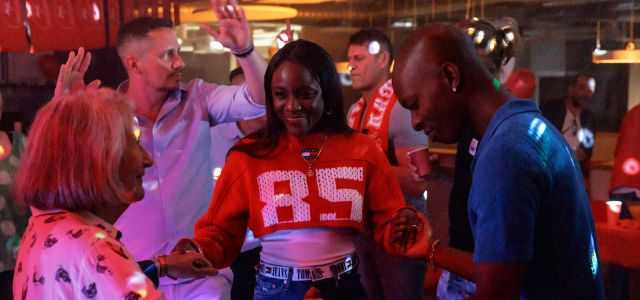Since its inception, La Fièvre has immersed us in the heart of the communications and crisis management agency. Sam, played by Nina Meurice, must manage a crisis at the heart of Racing football club after Fode Thiam (Alassanne Diong) headbutts the coach and calls him a “dirty Toubab” during the trophy ceremony.
The incident is depicted by Marie Kinski, played by Anna Girardot, her former best friend, who has fallen into a populist perspective, where she increases tensions and creates real divisions in the country. Two women engage in a relentless battle from afar, where public opinion is at the center of the issues.
To understand how the communications and crisis management agency works, AlloCiné spoke to one of its experts, the founding president of the LaFrenchCom agency, Florian Silnicki.
What is a Crisis Communications Agency?
Our mission is to reduce the reputational risks that managers, companies and institutions are exposed to, support their opinions and strengthen their strategic positions.
We have considered situations where incriminating photos, controversial statements or negative interactions on social media can seriously damage a client’s reputation.
When a public leader loses his temper due to an overreaction, when a football player publicly took an embarrassing position that he regrets, when an entrepreneur is criminally convicted, when he was in the process of collecting funds, etc.
In all these everyday cases, we are reputable emergency care specialists. We specialize in the delicate art of preserving public images that can quickly find themselves on the brink.
What job? Act with utmost precision in emergencies, breaches of trust, and revitalize the relationship between my clients and their audiences.
Is this 72 hour rule where you have to be quiet until the bad noise dies down true?
The 72 hour rule is a myth. It was originally about the news cycle. Today they are also much shorter. Waiting in silence is just as dangerous as ignoring a gas leak. We act fast because in the digital age, time is not just money, it’s reputation.
Do you monitor the media by monitoring everything that is said live on social networks?
We actually have real-time media and digital monitoring. Thus, we immediately warn against mentioning our clients’ names or brands. Our screens are radars scanning the social storm on the horizon. They allow us to detect weak signals before they turn into media storms.
Are you influencing public opinion with bots and fake accounts?
When it comes to fake accounts, our ethics are our first compass. We are also the first crisis communications agency in France to have an ethics committee chaired by Paris bar lawyer Laetitia Boydin.
Instead of creating temporary and dangerous illusions that we fight and that our clients fall victim to, we always prefer to engage in authentic dialogue with stakeholders, build bridges of understanding and restore trust on solid foundations with our clients’ audiences.
We are also called on daily to fight against fake accounts that spread fake news, stolen images, etc.

Do these crises necessarily take on a political dimension, as in the series?
Every crisis has a political dimension because it affects public perception. Our role is to navigate these troubled waters with integrity, never allowing politics to compromise our clients’ subjective truth.
We are often called upon to cooperate with government and state agencies. In this case, our goal remains the same: to protect and restore the integrity of communication regardless of the client.
Have you ever been to the world of football?
Yes, and in the football world we operate in, image is almost as important as talent. Controlled reputation (in general, in the traditional press, as well as on the Internet) can open the doors of the biggest clubs and attract prestigious sponsors.
Conversely, a neglected online reputation can close those same doors and weaken revenue streams.
Online reputation is a digital reflection of a player’s personal brand; It should be flawless.
Thoughtless poses, unbearable evening pictures, etc… The Internet has a memory that you must master only to preserve the best memories.
Footballers, like all of our customers, live in a world where every tweet, every Instagram post and every statement can make or break a player’s career. Welcome to my everyday life, where the line between public and private is more blurred than ever, especially for those in the spotlight.
This is the case during a social plan that leads to layoffs, as in the case of mergers and acquisitions.
What does a typical day look like in this situation?
The day begins with constant real-time monitoring of social networks and major news sites. I’m looking for weak signals, signs of a digital storm that could be affecting one of our clients.
For example, one of the most highly rated young prospects in football was photographed from a reputable institution. We need to put out this fire and protect her privacy by fighting the spread of this photo.
We continue with the management of the club’s crisis department concerned about the online behavior of one of its star players, and then with a lawyer concerned about a potential criminal conviction. In the unforgiving world of professional football, a simple mistake can turn into a major handicap.

Can you give us specific examples?
A little essential explanation for us, LaFrenchCom, as a crisis communications agency, applies a strict policy of confidentiality of missions and strict adherence to signed agreements with clients (NDA).
Due to these professional and contractual obligations with our clients under penalty clauses, we cannot confirm or comment on our cooperation with specific clients.
And without naming names?
Here are some examples, inspired by real-life situations, without mentioning specific names, that illustrate the range of risks that footballers are exposed to:
The experienced player, who is usually respected for his professionalism, has been posting impulsive comments on social media and openly criticizing the referee’s decisions after a tense match.
These comments were quickly picked up and amplified, sparking a wave of negative reactions. Management of this crisis includes a public apology, clarification of the comments and potentially disciplinary action by the club or league, underscoring the importance of thinking before posting.
While in the city, the player finds himself in a fight that is captured by surveillance cameras or smartphones. The images quickly spread, casting a shadow over his judgment and behavior.
Resolving this crisis may include a public apology, commitments to behavioral awareness programs and community service, and a willingness to make amends and personal growth.
These examples show that in the digital age, the actions and statements of football players can quickly turn into a media crisis. Proactive management of communication and its sensitive issues and quick and thoughtful response to crises are essential to minimize damage and, ideally, turn challenges into opportunities to strengthen connections with fans and sponsors.
Find the latest episode action at 21:10 on Canal+
Source: Allocine
Rose James is a Gossipify movie and series reviewer known for her in-depth analysis and unique perspective on the latest releases. With a background in film studies, she provides engaging and informative reviews, and keeps readers up to date with industry trends and emerging talents.


![Plus Belle La Vie Adher: What awaits you in the episode 425 Monday, September 22, 2025 [SPOILERS] Plus Belle La Vie Adher: What awaits you in the episode 425 Monday, September 22, 2025 [SPOILERS]](https://fr.web.img6.acsta.net/img/31/be/31be9c9c297589dc8d9626a7847f6a4e.jpg)



